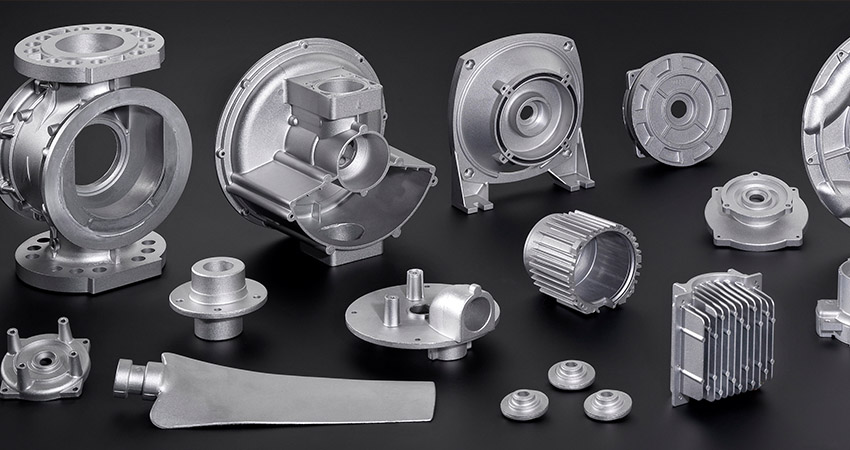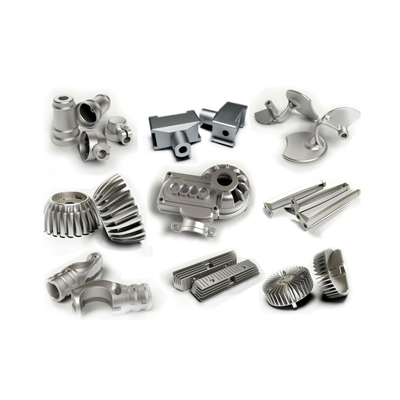The history of Aluminum Casting and its impact today
Wiki Article
A Comprehensive Guide to the Different Kinds and Applications of Aluminum Castings
Aluminum castings are essential parts in various markets, understood for their light-weight and durable buildings. Different casting approaches, such as sand, pass away, and investment casting, offer distinctive benefits customized to certain applications. Understanding these procedures is important for selecting the right approach for a task. Each method has its unique advantages, affecting style and manufacturing selections. The expedition of these techniques reveals a much deeper understanding into their influence on contemporary production.Introduction of Aluminum Castings
Aluminum castings are vital elements in various markets, recognized for their lightweight and corrosion-resistant buildings. These castings are produced with processes that permit detailed designs and high dimensional precision. The flexibility of aluminum makes it a suitable choice for a variety of applications, from automotive parts to customer electronic devices. Due to its superb thermal and electrical conductivity, aluminum is likewise preferred in electrical housings and warm sinks. Aluminum castings can be treated with numerous surface area coatings, enhancing their aesthetic charm and toughness. The product's recyclability includes in its sustainability credentials, making it an ecologically pleasant alternative. In addition, the availability of different aluminum alloys allows producers to tailor the mechanical residential or commercial properties to details demands, giving boosted strength or boosted resistance to use. Generally, aluminum castings play a considerable role in modern manufacturing, contributing to the effectiveness and performance of various products throughout varied sectors.Sand Casting: Refine and Applications
While different casting methods exist, sand casting stays among the most commonly made use of strategies due to its simplicity and adaptability. This process entails developing a mold and mildew from a mix of sand and a binding agent, permitting for the manufacturing of intricate shapes with high dimensional precision. The aluminum is thawed and poured right into the mold, where it takes the wanted form as it cools and strengthens.Sand casting is particularly efficient for producing big parts and low to tool volume runs, making it appropriate for different industries, including automobile, aerospace, and durable goods. Its adaptability permits the casting of detailed layouts, fitting varied requirements. In addition, sand molds can be recycled numerous times, boosting cost-effectiveness. The simplicity of sourcing materials and the fairly reduced arrangement expenses better contribute to its extensive adoption. In general, sand casting plays a pivotal duty in the aluminum casting landscape, promoting advancement and performance.
Die Casting: Advantages and Makes use of
Die casting offers numerous advantages that make it a recommended method for generating aluminum components in different markets. This process allows for high-volume manufacturing with phenomenal dimensional accuracy and surface finish. The fast solidification of aluminum during die casting causes a strong and long lasting item, reducing the demand for substantial machining or finishing processes.Furthermore, die casting makes it possible for the production of complex shapes and complex layouts, which can be challenging to achieve with various other casting techniques. The efficient use materials lowers waste, making it an affordable option for suppliers.
Applications of die casting span various industries, consisting of automobile, aerospace, and customer electronic devices, where light-weight and high-strength parts are vital. On the whole, die casting stands apart for its capability to deliver high quality, efficiency, and versatility in aluminum element manufacturing, strengthening its role in modern-day manufacturing methods.
Investment Casting: Precision and Detail
Investment casting is a precision manufacturing process that enables elaborate designs and in-depth attributes in aluminum components (Aluminum Casting). This technique offers many benefits, consisting of high dimensional precision and a smooth surface area coating. Its adaptability makes it relevant throughout various industries, from aerospace to clinical toolsProcess Summary
The investment casting process stands out for its capacity to generate complex aluminum elements with amazing precision and detail. This approach starts with creating a wax or polymer pattern that is a reproduction of the preferred part. Next off, the pattern is coated with a ceramic covering, which is after that heated up to set. Once the covering is established, the wax is dissolved, leaving a dental caries in the covering. Liquid aluminum is put into this dental caries, loading it to form the last component. After cooling down, the ceramic covering is escaped, exposing the cast component. This process permits intricate geometries and great surface area finishes, making it suitable for various applications, from aerospace to vehicle markets.Benefits of Investment Casting
Among the key advantages of financial investment casting hinges on its capability to supply high-precision components with intricate details. This approach permits the production of complex geometries that are usually unattainable with various other casting methods. Financial investment casting lessens the need for comprehensive machining, decreasing product waste and production time. In addition, it enables the use of numerous aluminum alloys, enhancing the flexibility of the final item. The procedure is characterized by a smooth surface area coating, which can cause boosted performance and visual appeals. Furthermore, investment casting is fit for both little and large manufacturing runs, fitting a vast array of sectors. Generally, its accuracy and efficiency make investment casting a recommended option for making components requiring exact specs.Applications in Market
While different casting methods offer specific functions, financial investment casting stands apart for its widespread applications across multiple sectors as a result of its unrivaled precision and information. This method is especially favored in aerospace and auto markets, where complex components require exact requirements for safety and security and performance. Investment casting permits the manufacturing of complicated shapes, such as generator blades and engine components, that standard techniques can not achieve. In addition, medical device suppliers use investment casting for creating very comprehensive instruments and implants, ensuring biocompatibility and capability. The electric and electronics sectors likewise profit, creating parts like real estates and ports that demand great resistances. Generally, investment casting's convenience and accuracy learn this here now make it a necessary procedure in modern production across varied fields.Contrast of Casting Methods

Sand Casting Advantages
Sand casting offers several advantages over other casting approaches, specifically when it concerns adaptability and cost-effectiveness. This strategy permits the manufacturing of complex forms and huge parts without the demand for expensive tooling. Furthermore, the sand made use of in this process is easily offered and low-cost, making it an eye-catching alternative for both small and large manufacturing runs. The capability to recycle sand advertises sustainability and reduces product expenses. Sand casting accommodates a you could try this out variety of aluminum alloys, enhancing its flexibility for various applications. The procedure is additionally fairly basic, which adds to much shorter preparations and versatility in production. These aspects make sand casting a recommended selection for lots of industries looking for reliable and economical services.Die Casting Efficiency
Although various casting methods are readily available, pass away casting stands apart for its efficiency, specifically in high-volume manufacturing circumstances. This method uses high-pressure pressures to infuse molten aluminum into a mold and mildew, causing fast cycle times and regular product quality. Contrasted to sand casting and investment casting, pass away casting significantly minimizes material waste and permits for elaborate layouts with limited tolerances. The capability to create large quantities of parts rapidly makes it ideal for markets such as auto and consumer items. On top of that, die casting can help with the use of cheaper alloys, further boosting its cost-effectiveness. On the whole, the performance of die casting makes it a favored selection for manufacturers aiming to enhance both manufacturing speed and quality.Financial Investment Casting Accuracy
Financial investment casting is commonly recognized for its extraordinary accuracy in producing complicated forms and complex details. This method involves producing a wax pattern, which is covered in a ceramic shell, and consequently dissolved, leaving a precise dental caries for molten aluminum. Compared to various other casting techniques, such as sand casting or die casting, financial investment casting supplies tighter tolerances and a smoother surface area finish. This precision makes it perfect for applications requiring high precision, such as aerospace and medical tool components. While the initial configuration prices may be higher, the lasting advantages include lowered machining requirements and constant top quality. Financial investment casting stands out as a recommended selection for complex styles and requiring specifications in different markets.Market Applications of Aluminum Castings
Aluminum castings play a crucial duty across many industries as a result of their lightweight, corrosion-resistant buildings and outstanding strength-to-weight proportion. In the auto field, aluminum castings are extensively used for engine parts, transmission real estates, and structural components, adding to sustain effectiveness and performance. The aerospace market benefits from aluminum castings in airplane structures, engine installs, and indoor installations, where weight reduction is crucial.Additionally, the customer electronics market makes use of aluminum castings for enclosures and parts, improving resilience while maintaining a smooth visual. In the building and construction market, aluminum castings are employed in building aspects, window frames, and architectural supports, supplying durability against weathering. The marine sector prefers aluminum castings for boat hulls and installations due to their resistance to saltwater deterioration. On the whole, aluminum castings provide functional services, fulfilling varied demands across numerous applications while keeping high efficiency and reliability.

Future Trends in Aluminum Casting Technology
As industries remain to develop, advancements in aluminum casting modern technology are poised to reshape manufacturing processes and product design. Arising patterns consist of the combination of automation and artificial knowledge, improving production and improving top quality control. 3D printing is also gaining traction, permitting for more intricate geometries and reduced waste, thus advertising sustainability. Furthermore, the advancement of high-performance alloys is increasing the applications of aluminum castings, allowing sectors to fulfill rigorous efficiency standards.One more substantial trend is the enhancing emphasis on recycling and the round economy, with innovations aimed at reusing aluminum scrap successfully. Industry gamers are additionally buying clever production techniques, integrating IoT for real-time monitoring and anticipating upkeep. Developments in surface therapy technologies are boosting the sturdiness and aesthetic charm of aluminum castings. Jointly, these patterns symbolize a transformative duration in aluminum casting, driving performance, sustainability, and innovation across numerous industries.
Often Asked Questions
What Are the Ecological Effects of Aluminum Casting Processes?
The ecological influences of aluminum casting processes consist of greenhouse gas emissions, energy usage, and waste generation. These aspects add to air and water pollution, prompting the need for sustainable practices and boosted resource management in the industry.Just How Can Aluminum Castings Be Recycled Successfully?
Reliable recycling of aluminum castings entails collecting scrap, eliminating contaminants, and thawing the aluminum to generate new castings. This procedure preserves power, reduces waste, and minimizes environmental influences, promoting a more sustainable manufacturing cycle.What Is the Typical Life Expectancy of Aluminum Castings?
The common life-span of aluminum castings differs significantly, often lasting between 20 to 50 years relying on environmental aspects, alloy composition, and application. Their longevity makes them suitable for various requiring industrial and structural uses.Are There Any Health Threats Connected With Aluminum Casting?
Problems concerning wellness risks connected with aluminum casting include prospective direct exposure to fumes and dust. Prolonged breathing might result in respiratory issues, while skin get in touch with can create inflammation. Proper safety measures are crucial to browse around this site alleviate these risks.Just How Do Aluminum Castings Compare to Other Products in Toughness?
Aluminum castings show a beneficial strength-to-weight ratio compared to several materials, including steel and plastics (Aluminum Casting). They are light-weight yet solid, making them excellent for applications requiring longevity without extreme weight, such as vehicle and aerospace partsReport this wiki page